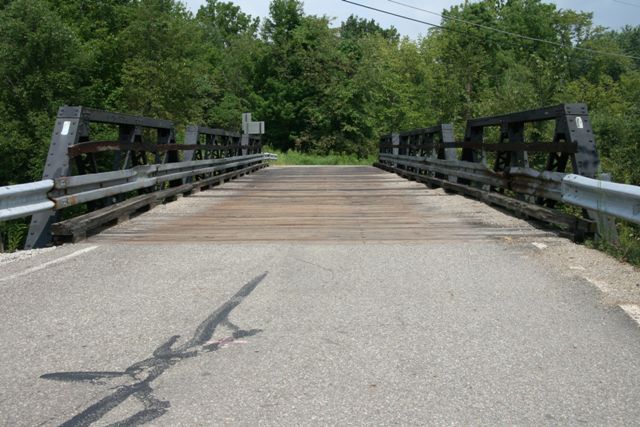We Recommend:
Bach Steel - Experts at historic truss bridge restoration.
BridgeHunter.com Phase 1 is released to the public! - Visit Now
Knapp Road Bridge

Primary Photographer(s): Rick McOmber
Bridge Documented: August 22, 2010
Rural: Portage County, Ohio: United States
Not Available or Not Applicable
44.0 Feet (13.4 Meters)
104.0 Feet (31.7 Meters)
18 Feet (5.49 Meters)
3 Main Span(s)
6741150

View Information About HSR Ratings
Bridge Documentation
This bridge no longer exists!
Bridge Status: Demolished and replaced.View Archived National Bridge Inventory Report - Has Additional Details and Evaluation

This bridge is a grade separation that carries highway over railroad. The historic bridge inventory provides a good discussion. The bridge design was not restricted to Ohio, since it appears on other sections of this railroad line such as in Indiana. The bridge design is recognized by its multi-span pony truss configuration, use of built-up steel bents, and unusual use of a pin and hanger on a bridge with riveted truss connections to attach the floorbeams to the trusses.
Information and Findings From Ohio's Historic Bridge InventorySetting/Context The bridge carries one lane of a 2 lane road over a 2 active railroad tracks of the former B&O RR main line now operated by CSXT. The road is immediately south of SR 5 and the WW II Ravenna Arsenal munitions plant. The line was double tracked in the early 20th century, and this overpass appears to be part of that improvement campaign. There are curves at both ends of the bridge; the approach road geometry and sight lines are substandard. There is modern development on the Physical Description The 3 span, 104'-long, rivet-connected Warren pony truss bridge has a 44' span over the tracks flanked by 30'-long spans. The bridge deck is about 15' wide. The truss lines are traditionally composed with angles and plates, but what is rarely seen is a riveted bridge with suspended floorbeams using U-shaped hanger or suspenders around a traditional pin at the lower panel point. The detail is transitional and represents ease of erection. There have been in kind repairs and replacement of original fabric, including new rolled floorbeams, wood plank deck, reconstruction of one of the column bents, high-strength bolts for rivets, and portions of the lower chords. The original pipe railings have been lost, and the current railings have impact damage. Integrity There is replacement material, but maintains aspects of integrity. Summary of Significance The 1904 bridge is one of seven, similar design,
riveted Warren pony truss bridges located over the former B&O Railroad's
main line between Baltimore and Chicago that were placed between 1904
and 1907. The bridges are historically and technologically significant
as early and complete examples of their bridge type and for their
association with the development and operation of a major trunk railroad
linking mid-western and eastern markets. Initially developed starting in
1890, the main line to Chicago was double tracked in the early 1900s,
and the overpass bridges date from that improvement campaign. Three
additional bridges of the same design that are located in Ashland and
Trumbull counties, and there are others over the main line in Indiana
(Noble County). Justification Of the over 140 examples built between 1897 and 1960, only 13 predate 1910, which makes early ones not common. This example has high significance because it is the second oldest documented extant example in the state and for its association with one of the most important railroad lines through the state. Bridge Considered Historic By Survey: Yes |
![]()
Photo Galleries and Videos: Knapp Road Bridge
Bridge Photo-Documentation
Original / Full Size PhotosA collection of overview and detail photos. This gallery offers photos in the highest available resolution and file size in a touch-friendly popup viewer.
Alternatively, Browse Without Using Viewer
![]()
Bridge Photo-Documentation
Mobile Optimized PhotosA collection of overview and detail photos. This gallery features data-friendly, fast-loading photos in a touch-friendly popup viewer.
Alternatively, Browse Without Using Viewer
![]()
Maps and Links: Knapp Road Bridge
This historic bridge has been demolished. This map is shown for reference purposes only.
Coordinates (Latitude, Longitude):
Search For Additional Bridge Listings:
Bridgehunter.com: View listed bridges within 0.5 miles (0.8 kilometers) of this bridge.
Bridgehunter.com: View listed bridges within 10 miles (16 kilometers) of this bridge.
Additional Maps:
Google Streetview (If Available)
GeoHack (Additional Links and Coordinates)
Apple Maps (Via DuckDuckGo Search)
Apple Maps (Apple devices only)
Android: Open Location In Your Map or GPS App
Flickr Gallery (Find Nearby Photos)
Wikimedia Commons (Find Nearby Photos)
Directions Via Sygic For Android
Directions Via Sygic For iOS and Android Dolphin Browser
USGS National Map (United States Only)
Historical USGS Topo Maps (United States Only)
Historic Aerials (United States Only)
CalTopo Maps (United States Only)

